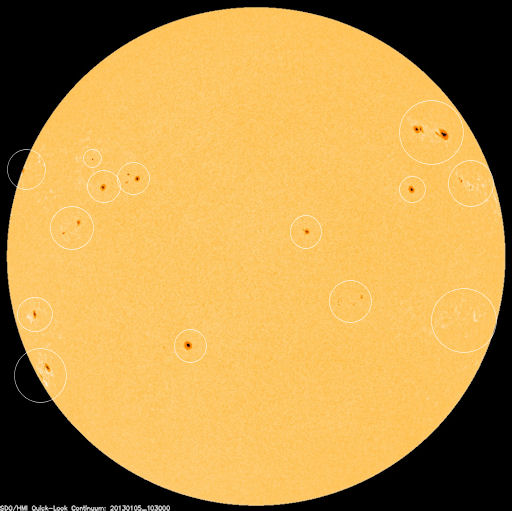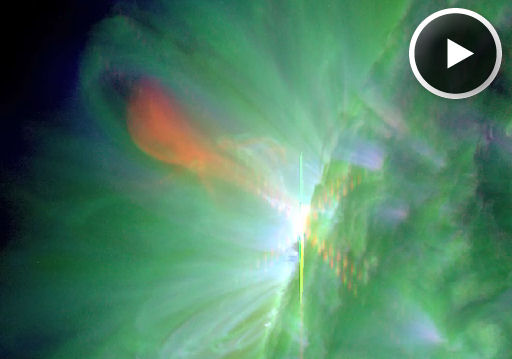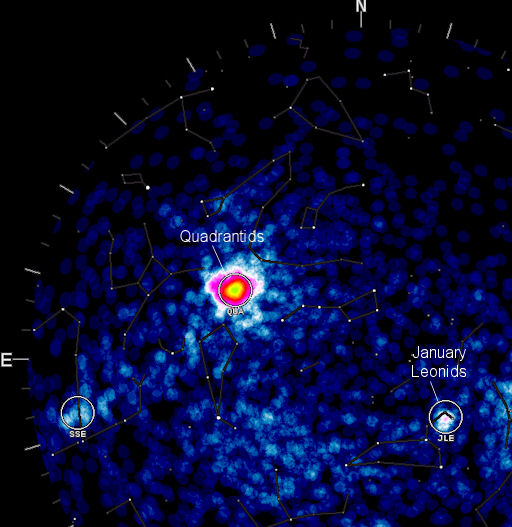Thirty-five new items have just been added to our Meteorite Jewelry collection. Browse the Space Weather Store for something out of this world. | | |
INCREASING CHANCE OF FLARES: The sun is peppered with spots: There are now more than a dozen numbered active regions scattered around the solar disk. As the sunspot count increases so does the chance of flares. NOAA forecasters estimate a 25% chance of M-class eruptions and a 5% chance of X-flares during the next 24 hours. Solar flare alerts: text, voice.
To illustrate the growing spottiness of the sun, each active region in this Jan. 5th image from NASA's Solar Dynamics Observatory (SDO) is circled:

The most active sunspot so far is emerging over the sun's northeastern limb. On Jan. 5th at 09:34 UT, the unnumbered region unleashed an M1.7-class eruption that sent a wave of ionization rippling through the upper atmosphere over Europe. The flare was too brief, however, to produce a significant CME. SDO recorded a movie of the explosion's extreme ultraviolet flash:

More flares appear to be in the offing; stay tuned.
Realtime Space Weather Photo Gallery
TWO METEOR SHOWERS IN PROGRESS: The annual Quadrantid meteor shower, caused by debris from shattered comet 2003 EH1, peaked on Jan. 3rd and should be finished--but maybe not. "The Canadian Meteor Orbit Radar (CMOR) is still seeing strong Quadrantid activity," reports Prof. Peter Brown of the University of Western Ontario. "The overnight results have just been processed, and here is a skychart plot showing radiant activity as it appeared around 5 am EST on the morning of Jan. 4th."

"Notice also the relatively strong shower coming right out of the head of Leo," points out Brown. "This is the fast (54 km/s) January Leonids (JLE), first detected a few years ago by CMOR, but usually overlooked as it peaks the same day as the Quadrantids."
"The January Leonid shower is unusual in that it is quite strong (10 meteors per hour) and has an orbit which gets very close to the Sun (perihelion about 0.05 AU). In fact, it has the smallest perihelion of any major shower detected by CMOR. It also has a nearly unbound orbit and is almost certainly associated with an as yet unidentified sungrazing comet. Very little is known about the stream - optical observations would be most helpful, particularly to define the orbit at larger meteoroid sizes. The shower remains active as seen by CMOR until Jan 7."
Realtime Meteor Photo Gallery
Realtime Aurora Photo Gallery
Realtime Noctilucent Cloud Photo Gallery
[previous years: 2003, 2004, 2005, 2006, 2007, 2008, 2009, 2011]
Potentially Hazardous Asteroids (
PHAs) are space rocks larger than approximately 100m that can come closer to Earth than 0.05 AU. None of the known PHAs is on a collision course with our planet, although astronomers are finding
new ones all the time.
On January 5, 2013 there were 1364 potentially hazardous asteroids.
Notes: LD means "Lunar Distance." 1 LD = 384,401 km, the distance between Earth and the Moon. 1 LD also equals 0.00256 AU. MAG is the visual magnitude of the asteroid on the date of closest approach. | | The official U.S. government space weather bureau |
| | The first place to look for information about sundogs, pillars, rainbows and related phenomena. |
| | Researchers call it a "Hubble for the sun." SDO is the most advanced solar observatory ever. |
| | 3D views of the sun from NASA's Solar and Terrestrial Relations Observatory |
| | Realtime and archival images of the Sun from SOHO. |
| | from the NOAA Space Environment Center |
| | the underlying science of space weather |

